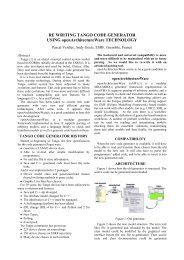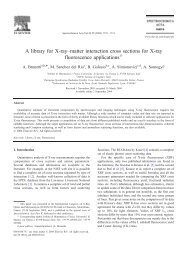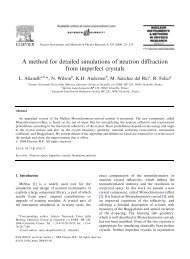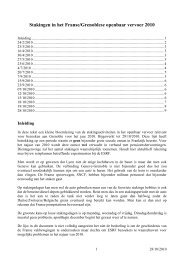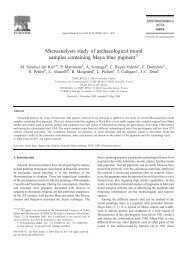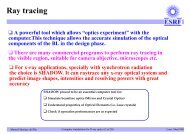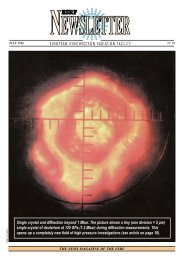Report on future detector requirements at ESRF
Report on future detector requirements at ESRF
Report on future detector requirements at ESRF
Create successful ePaper yourself
Turn your PDF publications into a flip-book with our unique Google optimized e-Paper software.
Sp<strong>at</strong>ial resoluti<strong>on</strong>:<br />
A 2D <strong>detector</strong> is necessary to record both the direct image and the diffracted spots in all the<br />
directi<strong>on</strong>s perpendicular to the beam (a maximum of spots is necessary to rec<strong>on</strong>struct the<br />
shape of the grains, <strong>on</strong>e quadrant is not enough).<br />
Sp<strong>at</strong>ial resoluti<strong>on</strong> is used both for direct imaging of the sample and localis<strong>at</strong>i<strong>on</strong> of the<br />
diffracti<strong>on</strong> spots around the image (centroid, area, intensity,…). A pixel size of 1 to 3 µm is<br />
required for imaging. A large field of view is needed to collect the widest possible part of the<br />
diffracti<strong>on</strong> p<strong>at</strong>tern. The image is recorded in parallel beam but the distance between the<br />
sample and the <strong>detector</strong> can be varied in order to adapt the solid angle of collecti<strong>on</strong> of the<br />
diffracted signal. A field of view of 4kx4k pixels (th<strong>at</strong> is 4 x 4 mm 2 with 1 µm pixel size)<br />
would be appreci<strong>at</strong>ed. Since the symmetrical diffracti<strong>on</strong> spots (Friedel pairs) are studied, the<br />
useful field of view is square and not rectangular.<br />
Efficiency:<br />
Efficiency should be improved, particularly <strong>at</strong> high energy. The problem is th<strong>at</strong> the diffracted<br />
beams do not reach the scintill<strong>at</strong>or normally to the surface but with an angle th<strong>at</strong> broadens the<br />
spot. Thus the scintill<strong>at</strong>or should be as thin as possible, even more than for other high<br />
resoluti<strong>on</strong> applic<strong>at</strong>i<strong>on</strong>s.<br />
Dynamic range:<br />
Since the number of phot<strong>on</strong>s per pixel is approxim<strong>at</strong>ely 10 to 100 times higher in the sample<br />
image than in the diffracted spots, dynamic range is a important issue. It should be <strong>at</strong> least as<br />
it is now: 14 bits.<br />
Linearity:<br />
Current linearity obtained with the FReLoN camera is s<strong>at</strong>isfactory.<br />
Flux <strong>on</strong> <strong>detector</strong>:<br />
Flux will be highly dependant <strong>on</strong> the beamline hosting this <strong>detector</strong>. It will be <strong>at</strong> least<br />
comparable to the <strong>on</strong>e currently obtained <strong>at</strong> ID19, th<strong>at</strong> is between 10 8 and 10 9 phot<strong>on</strong>s/s/mm 2 .<br />
Fluxes foreseen <strong>on</strong> MIA are 10 10 to 10 13 phot<strong>on</strong>s/s/mm 2 for the transmitted beam. Thus, <strong>on</strong>e<br />
can foresee 10 8 to 10 11 phot<strong>on</strong>s/s/mm 2 for the diffracted spots.<br />
Particular oper<strong>at</strong>ing c<strong>on</strong>diti<strong>on</strong>s:<br />
Since this set-up will be installed <strong>on</strong> different beamlines, lightness and ease of install<strong>at</strong>i<strong>on</strong> <strong>on</strong><br />
any experimental envir<strong>on</strong>ment would be useful. It should be thought, for example, to separ<strong>at</strong>e<br />
even more than in the current FReLoN camera the cooled sensor head from the rest of the<br />
<strong>detector</strong>.<br />
Required <strong>detector</strong><br />
The required <strong>detector</strong> is a high resoluti<strong>on</strong> 2D <strong>detector</strong>.<br />
Existing <strong>detector</strong>s<br />
For this applic<strong>at</strong>i<strong>on</strong>, FReLoN <strong>detector</strong>s (Atmel 2k14 and Kodak 4M) are currently used.<br />
Short term possibilities<br />
A 4kx4k sensor could be used in frame transfer mode to increase the duty cycle.<br />
Main required improvements<br />
The main expected improvements c<strong>on</strong>cern the efficiency and the field of view.<br />
40



